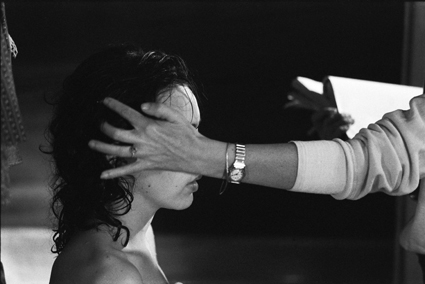
Visual artist by training, Christiane Grimm came as a co-writer on the set of Francis Reusser’s film after having already collaborated with him in 1980 for her film “Seul”. This Swiss film production was considered as the most important moving picture of 1985. Christiane Grimm, attracted by the special climate that prevailed on the film, ie the v [...]
Visual artist by training, Christiane Grimm came as a co-writer on the set of Francis Reusser’s film after having already collaborated with him in 1980 for her film “Seul”. This Swiss film production was considered as the most important moving picture of 1985. Christiane Grimm, attracted by the special climate that prevailed on the film, ie the village of Haute-Valais, Les Haudères completely transformed into a film set, and Grimm obtained a camera and spontaneously captured the permanence of the comings and goings between fiction and reality.
One of the qualities of Christiane Grimm’s photographs, such as the very aesthetic treatment of black and white, is to produce a kind of synthesis by uniting the fiction of the film and the documentary side of the shoot that breaks the fiction. The black-and-white photographs produce a temporal distance while representing amongst other tools that have nothing to do with the work of the traditional villagers , but everything with the film production two centuries later.
In 2014, the CPG featured a series of photographs that lay between fiction and documentary. They were the work of Christiane Grimm, who had shot them during the filming of Derborence, which she co-wrote with the film’s director, Francis Reusser. Exploring light, the raw material of photography since the 1990s, she co-published with physicist Libero Zuppiroli, a professor and researcher at EPFL, Traité de la lumière (Treatise on Light)in 2009, and Traité des couleurs (Treatise on Colours)in 2012. She shot the photographs herself for the latter. LeThéâtre des corps (The Theatre of Bodies)from 1993 is presented for the first time on a screen for OSMOSCOSMOS. When it was first shown in 1993, the critic André Klopmann wrote in the Journal de Genèvethat the artist succeeded in creating “…a little model of modesty and eroticism combined, since these themes do not cancel one another out when you know how to treat emotions.”